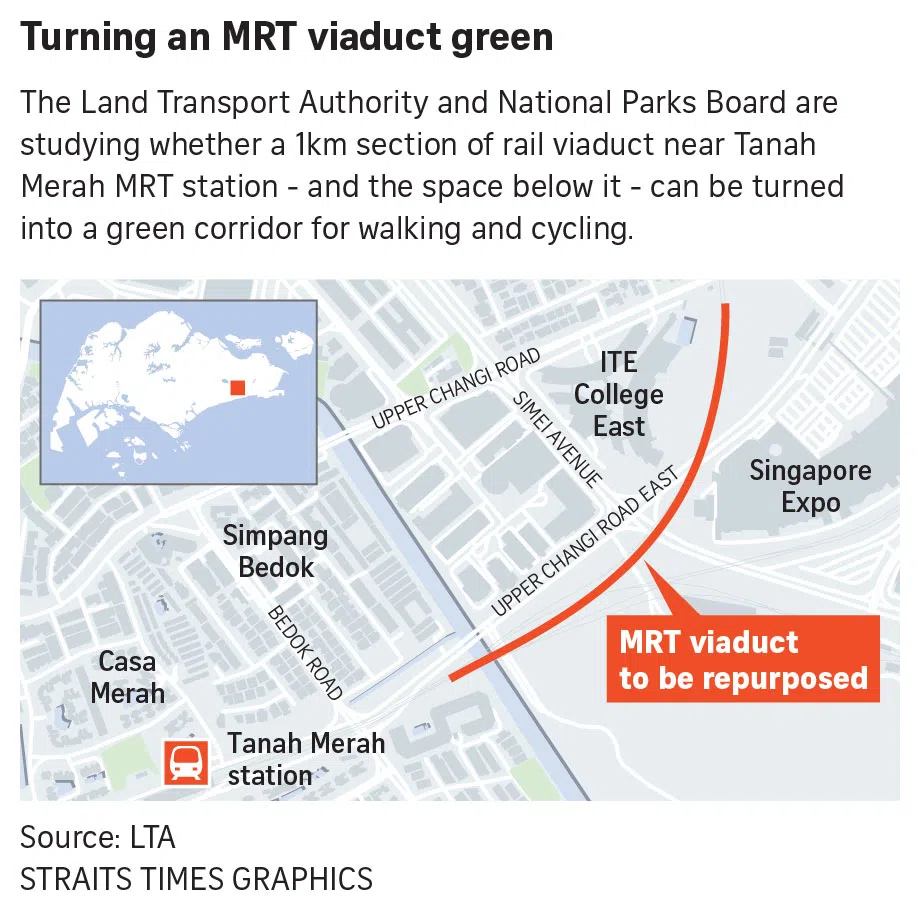Tanah Merah MRT viaduct may be turned into elevated green corridor when decommissioned in 2026
Sign up now: Get ST's newsletters delivered to your inbox
Follow topic:
SINGAPORE - The authorities here are studying whether a 1km section of rail viaduct near Tanah Merah MRT station – and the space below it – can be turned into a green corridor for walking and cycling.
The section of viaduct, which leads to Simei MRT station on the East-West Line (EWL), will become defunct in 2026 as it will be replaced by a new MRT track that will run parallel to it.
Instead of demolishing the viaduct, the idea is to convert the 1km stretch into a space for active mobility or a green corridor, Transport Minister S. Iswaran said in a Facebook post on Nov 3.
Concept art that Mr Iswaran shared in his post shows how it can be turned into an elevated walkway with plants growing on both sides, and on the pillars below. The artist’s impressions are reminiscent of the High Line – a 2.3km-long elevated public park in New York built on a disused freight rail line.
The images show sheltered seating areas on the repurposed viaduct and a ramp providing access from ground level.
Mr Iswaran said the idea to repurpose the viaduct came from feedback by residents in the neighbourhood, and there are plans to engage the public when more details are available.
The Land Transport Authority (LTA) is working with the National Parks Board to study the feasibility of the plan and a tender for consultancy services has been called, he said.
According to government procurement website GeBiz, the LTA on Nov 3 put out a tender for advance architecture and engineering services for the repurposing of the MRT viaduct and its associated space, with a contract delivery date of March 28, 2025.
Mr Iswaran said: “We are always looking for innovative ways to make our transport infrastructure greener... We welcome more of such suggestions.”
The 1km section of viaduct being studied runs along Upper Changi Road East, roughly between Bedok Park Connector and ITE College East.
It is being made redundant because of the construction of a third platform on the north side of Tanah Merah station, and the construction of a fourth MRT track for trains travelling to Pasir Ris from Tuas Link.
There are currently two platforms and three tracks at Tanah Merah. The outer two tracks are used for regular EWL train service, while the middle track is for trains travelling to Expo and Changi Airport, and back.
The new platform will allow for two new middle tracks at Tanah Merah station for trains to and from the airport.
These works, which also include extending the EWL tracks to connect to the new East Coast Integrated Depot at Changi, are scheduled to be completed in 2025, after which the 1km section of old rail viaduct will be decommissioned.
LTA’s longer-term plan is to eventually convert Tanah Merah, Expo and Changi Airport stations into part of a new Thomson-East Coast Line (TEL) extension. This extension will link the upcoming Sungei Bedok station on the TEL with Changi Airport, and it will also pass through the future Terminal 5
Mr Satya Ramamurthy, global co-head of public transport at professional services firm KPMG, said transformation of decommissioned rail lines and highways into community or natural spaces has been done in other major cities.
If successful, the Tanah Merah project could act as a “pathfinder” for developing shared spaces here with little to no resource consumption, he said.
Ms Ivy Koh, director of SJ Architecture, a member of Surbana Jurong Group, said it may be possible to build one to two storeys above the viaduct if building and planning guidelines allow.
“Reusing existing infrastructure tells a good story of sustainability. Demolishing concrete infrastructure assets results in a very high carbon footprint,” she said.
The key is not to view this 1km stretch on its own, said Mr Wang Wei, director for master planning and urbanism at Ramboll Singapore. “If we look at the High Line as an example, the power of the adaptive reuse was the transformation that it led to in Chelsea and Hudson Yards in Manhattan... Could we think of it (the stretch) as a catalyst that could be integrated with the Singapore Expo?”
National University of Singapore transport infrastructure expert Raymond Ong said turning the viaduct into a green corridor would provide greater connectivity to East Coast Park, Changi Airport, Tampines and Pasir Ris.
Mr Chintan Raveshia, cities business leader for South-east Asia at consultancy firm Arup, said the repurposing of the viaduct presents an opportunity to convert parts of the road below into car-free zones that could house public spaces such as performance areas.
Mr Tan Wooi Leong, energy and industrial managing director at Surbana Jurong, suggested installing solar panels along the repurposed viaduct – subject to studies on glare and the impact on nearby train operations.
But the experts also said there are limitations to what can be done with the viaduct due to its narrow footprint.
One downside, noted Mr Wang, is that it sits between functioning railway tracks, so it will be noisy and views will most likely be blocked. Creative designs may be needed to mitigate these issues.

Mr Aaron Foong, managing director of engineering firm KTP, which is also a member of the Surbana Jurong Group, said rail viaducts are structurally robust enough to support recreational activity, but there are still several factors to consider. These include crowd control, the placement of emergency exits, and security.
East Coast GRC MP Jessica Tan, who oversees the Changi-Simei ward, welcomed the LTA’s study and said the target is for the authority to award the consultancy services tender in 2023.
Residents and other community stakeholders, such as the Institute of Technical Education, will be engaged during the early stages of the design process, she added.


